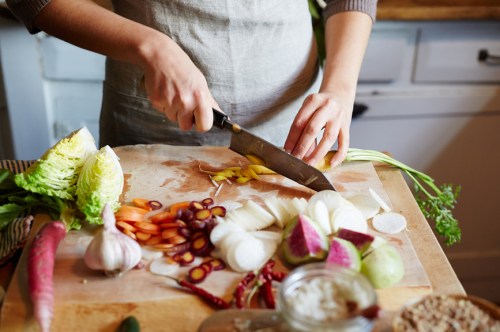Saying that “preparing Thanksgiving dinner is no easy feat” might just be the understatement of the century. From attempting to make your table look like it’s out of a Williams-Sonoma Christmas catalogue and making sure not to seat that one cousin who’s on the outs with that one uncle next to each other to finding the ideal chic-yet-elastic-waistbanded outfit is a journey—and we haven’t even gotten to the actual cooking part.
Experts in This Article
chef and owner of Braised &
Herve Malivert is a top chef and the director of culinary affairs at the Institute of Culinary Education in NYC.
Executive chef and owner of Matsu Restaurants
There are always a million balls to juggle in the days prior to the big event, which means every bit of advice when it comes to speeding up the process is much appreciated. One task that will majorly lighten your load? Being more strategic and skilled when tackling the meal’s produce prep. While seasoning, stuffing, and slicing a turkey certainly isn’t easy, let’s be honest: The real heavy-lifting happens between you and your chef’s knife. Your devotion to piling your table with fruit and veggie-rich sides is admirable, but without solid knife skills, dicing a dozen apples, stemming a massive bowl of brussels sprouts, and peeling enough potatoes to feed a small army can be taxing on your wrists (and TBH, your stamina to celebrate).
“Practice makes perfect when it comes to knife skills,” says professional chef Herve Malivert, director of culinary affairs at the Institute of Culinary Education. Here, find for six chef chopping tips from chef Malivert that will make prepping for Thanksgiving—and every other meal—a breeze.
6 professional chef chopping tips that will save your sanity
1. Prep your knives ahead of the big day.
Making sure to have a sharpened knife before you start your prep is paramount to getting the job done quickly, easily, and safely, says Malivert. “Sharp knives are safer because they won’t slip and don’t require as much force to cut as well,” agrees William Eick, chef-owner of Naegi. “When you use a dull knife, more pressure is used because the knife is not doing the work, and more pressure is dangerous because if you slip then you can really injure yourself,” adds Devan Cameron, professional chef and founder of Braised & Glazed. A sharp knife will also, of course, cut through your food much easier, which will in turn require much less energy from yourself.
To find out the most effective, easy way to sharpen your knives, find our guide here.
2. Make sure you have the tools you need.
In addition to keeping your go-to knife sharp, Malivert strongly recommends stocking up on these three types of kitchen knives that will help you get every job done on Thanksgiving day. These include:
- An 8-inch chef’s knife (also called utility knife or cook’s knife) — Consider this your sous chef. It should feel comfortable and balanced, almost like an extension of your hand.
- A paring knife — These are great for finer prep work, like peeling or deveining.
- A bread knife — Its serrated edge works wonders on crusty loaves of sourdough and baguette, but it’s also a lifesaver for slicing ripe tomatoes.
3. Hold your knife properly.
Seriously, once you nail this part of the produce prep process, you’ll shave hours off of the time you spend in the kitchen for years to come. “Having correct hand positioning on the knife is essential,” says Malivert. “To grip the knife properly, put your middle, ring, and pinky fingers around the handle, and grip the blade with your index finger and thumb. Then, to correctly chop, hold the item with one hand and then keep the tip of your knife on your board and with the other move up and down.”
4. Square the bottoms of round items before you chop them.
When you prep, squaring the bottom section of round items to secure them properly on your board will make chopping evenly-sized pieces a breeze. “Making one side of an onion, potato, squash, or other round root veg flat on your board also makes it easier to steadily practice your knife skills with different types of cuts,” Mailvent says. See also: the next tip.
5. Nail these two essential styles of slicing.
Two of the most ubiquitous and sanity-saving knife techniques Malivert shares are the chiffonade and battonet. The chiffonade is a knife technique usually reserved for cutting herbs and greens. “To do this properly, stack your herbs according to size—from small to large—to ensure that your cuts are even and approximately the same size. Use the knife in a rocking motion to shave the greens. Avoid chopping up and down, as this will bruise and possibly discolor the leaves,” explains Malivert.
Next, the battonet: Basically, a fancy way to refer to dicing. “To dice properly, first cut your food into several square-sided pieces of equal length. After placing these pieces in a row, cut the whole group into battonets and then you can proceed to cut again into cubes,” Malivert says. Voila, perfectly uniform cubes of carrot or cucumber with zero effort required.
6. Use a peeler for more than just peeling.
For carrots, zucchini, and other peeled vegetables, after you’re done peeling, Malivert recommends continuing to use the peeler to make some long ribbon or pappardelle-like shapes for salads or a quick sauté. Try it with asparagus for an asparagus salad, or make thin ribbons of potato to roast au gratin. It looks fancy, but you’re really just making your own life easier. After all, the smaller the slice, the faster the food will cook—and that’s something we can always get behind.
Oh hi! You look like someone who loves free workouts, discounts for cutting-edge wellness brands, and exclusive Well+Good content. Sign up for Well+, our online community of wellness insiders, and unlock your rewards instantly.
Sign Up for Our Daily Newsletter
Get all the latest in wellness, trends, food, fitness, beauty, and more delivered right to your inbox.
Got it, you've been added to our email list.










